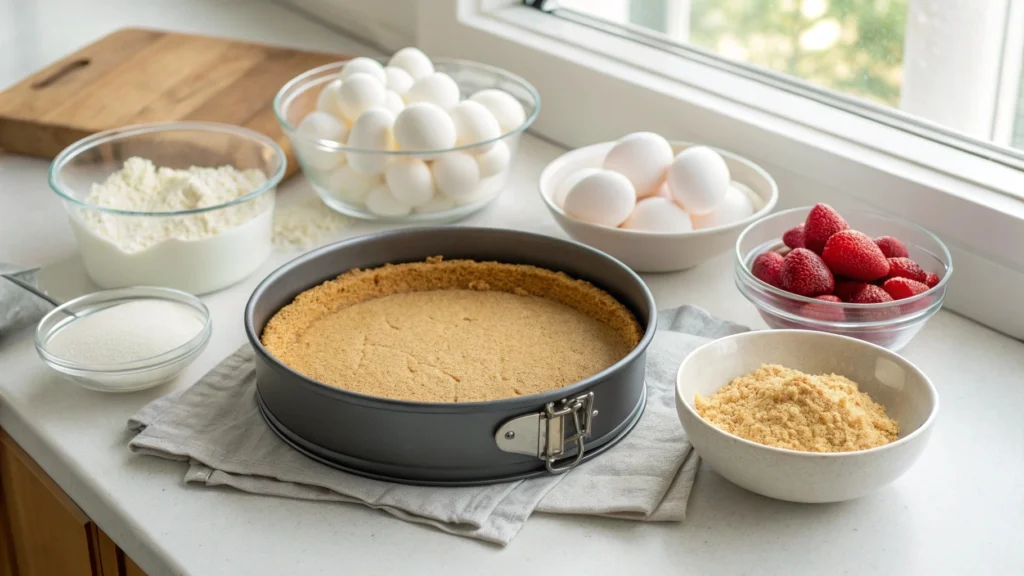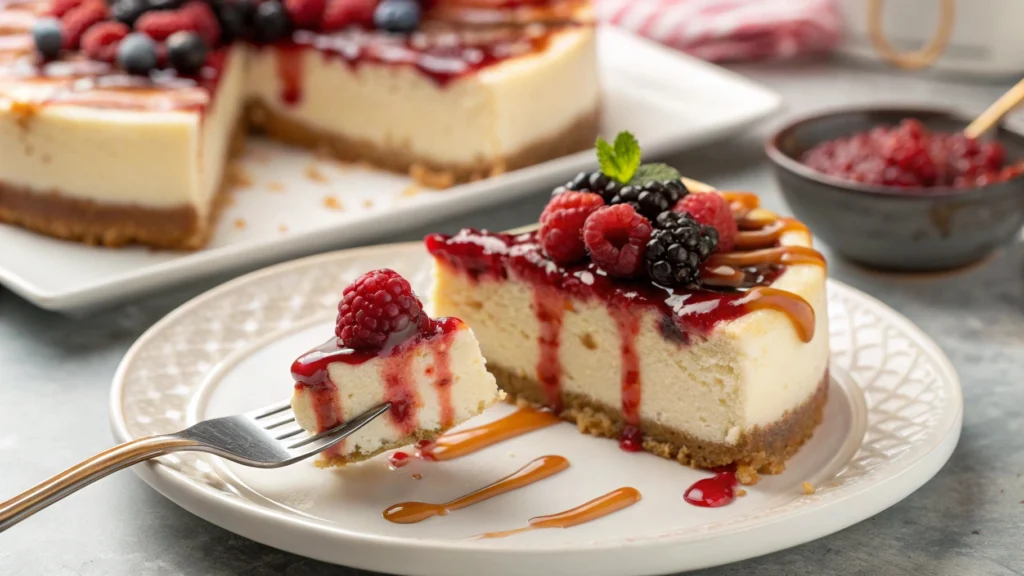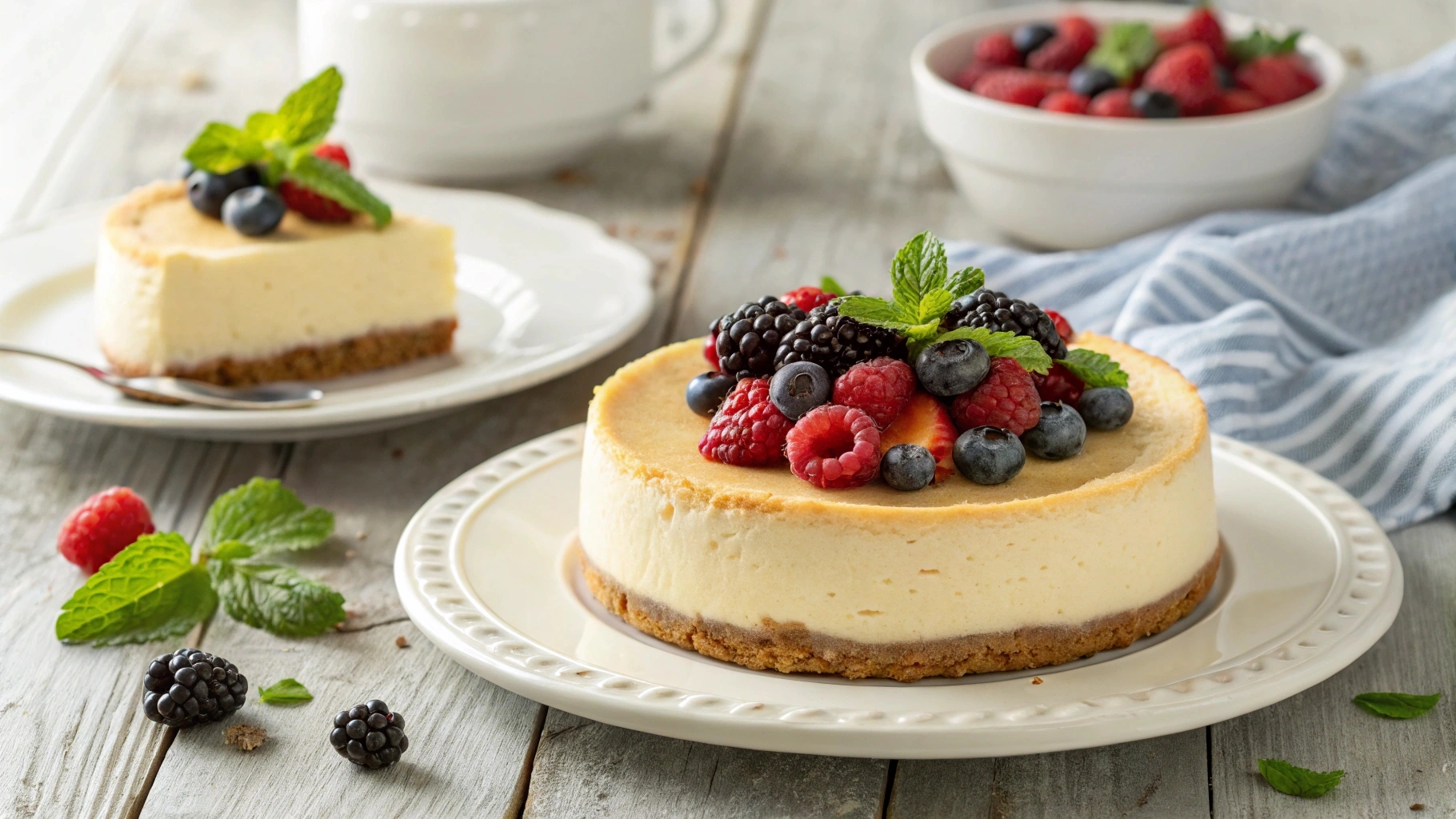Mascarpone cheesecake is a decadent twist on the traditional dessert, offering a luscious texture and a richer flavor profile that sets it apart. Whether you’re a cheesecake enthusiast or a curious baker looking to try something new, this guide is here to help you master the art of making mascarpone cheesecake.
From understanding its origins and key ingredients to step-by-step instructions and troubleshooting tips, we’ll cover everything you need to know. Plus, you’ll discover exciting variations, serving ideas, and answers to common questions about this crowd-pleasing dessert. Let’s dive into the world of mascarpone cheesecake!
What is Mascarpone Cheesecake?
Origins of Mascarpone Cheese
Mascarpone cheese hails from the Lombardy region of Italy, where it was first crafted in the late 16th century. Traditionally, mascarpone is made by curdling cream with citric or tartaric acid, which creates its signature velvety texture. Known for its mild, slightly sweet flavor, mascarpone is a staple in Italian cuisine, famously used in desserts like tiramisu and cannoli.
This luxurious ingredient found its way into cheesecakes, elevating them with a creamy richness unmatched by standard cream cheese. The Italian-American fusion of mascarpone cheesecake celebrates both tradition and innovation.
What Makes Mascarpone Cheesecake Unique?
Unlike the tangy sharpness of regular cheesecake made with cream cheese, mascarpone cheesecake has a smoother, silkier consistency with a mild sweetness. This makes it perfect for pairing with a variety of flavors, from fresh berries to chocolate.
Additionally, the high-fat content of mascarpone results in a richer, more indulgent dessert. The texture is often described as airy yet dense, offering a melt-in-your-mouth experience that’s hard to forget.
Why Choose Mascarpone Cheesecake?
Ingredients and Tools for Perfect Mascarpone Cheesecake
Essential Ingredients
Making a show-stopping mascarpone cheesecake starts with top-quality ingredients. The hero here is mascarpone cheese, which lends the dessert its signature creamy and slightly sweet flavor. Opt for fresh, high-fat mascarpone for the best results. If you’re in a pinch, a blend of cream cheese and heavy cream can mimic its rich texture, but the taste won’t be identical.
Other essentials include:
- Eggs: Provide structure and richness. Room-temperature eggs work best for smooth blending.
- Sugar: Adds sweetness without overpowering the mascarpone’s delicate flavor.
- Heavy Cream: Helps achieve a silkier consistency.
- Vanilla Extract: A splash enhances the natural flavors.
- Crust Base: Traditional graham crackers or biscuits work beautifully. For a twist, try crushed shortbread or almond cookies.
Must-Have Baking Tools
To create a professional-quality cheesecake, you’ll need a few tools:
- Springform Pan: Essential for easy removal without damaging the cheesecake.
- Mixing Tools: A stand or hand mixer ensures the mascarpone filling is lump-free.
- Measuring Tools: Accurate measurements are key in baking.
- Water Bath Setup: Prevents cracking during baking by regulating temperature.
Equipping yourself with these items simplifies the process, ensuring consistent and delicious results every time.
For a more creative crust idea, consider exploring this recipe for unique crust bases.
Step-by-Step Guide to Making Mascarpone Cheesecake
Preparing the Crust

Start with the crust the foundation of your mascarpone cheesecake. Combine crushed graham crackers with melted butter and sugar, then press the mixture into the bottom of a springform pan. For extra flavor, add a pinch of cinnamon or nutmeg. Chill the crust for 15–20 minutes to set.
Mixing the Filling
The filling is where the magic happens. Beat the mascarpone cheese until smooth, then add sugar and mix until fluffy. Incorporate the eggs one at a time, mixing gently to avoid overbeating. Finally, stir in heavy cream, vanilla extract, and any optional flavorings, such as lemon zest or cocoa powder.
A pro tip: Sift your sugar before mixing to ensure a silky texture.
Baking Techniques
Preheat your oven to 325°F (163°C). Pour the filling over the crust and smooth the top with a spatula. Place the pan in a larger baking dish filled with hot water (a water bath) to prevent cracks. Bake for 55–65 minutes or until the edges are set but the center jiggles slightly.
Once baked, turn off the oven and leave the cheesecake inside with the door ajar for an hour. This gradual cooling prevents sudden temperature changes that can cause cracks. Refrigerate for at least 4 hours or ideally overnight before serving.
For a visual guide on mastering these steps, check out this cheesecake baking tutorial.
Popular Variations and Recipes
Classic Mascarpone Cheesecake
The beauty of a classic mascarpone cheesecake lies in its simplicity. This version keeps the spotlight on the mascarpone’s creamy richness, paired with a subtle vanilla undertone. Use a buttery graham cracker crust as the base, and top with a light dusting of powdered sugar or fresh berries for a touch of elegance.
A fun tip: Adding a splash of lemon juice or zest can brighten the flavors, giving it a fresh and zesty twist.
Creative Twists on Mascarpone Cheesecake
For those who enjoy experimenting in the kitchen, mascarpone cheesecake is incredibly versatile. Here are some creative variations to try:
- Berry-Topped Cheesecake: Add a layer of blueberry or raspberry compote for a fruity, vibrant topping.
- Chocolate-Infused Mascarpone Cheesecake: Blend melted dark chocolate into the filling for a decadent, chocolatey treat.
- No-Bake Mascarpone Cheesecake: Skip the oven and opt for a chilled cheesecake with a gelatin-based filling. It’s perfect for warm summer days.
Tips for Serving and Storing Mascarpone Cheesecake
Best Practices for Serving
Presentation is key when serving mascarpone cheesecake. Here are a few ideas:

- Simple Elegance: Dust with powdered sugar and garnish with mint leaves.
- Pairing Suggestions: Serve with a drizzle of honey, a dollop of whipped cream, or a side of fresh fruit. For drinks, pair with coffee, tea, or dessert wine to complement the creamy richness.
When cutting the cheesecake, use a sharp knife dipped in warm water and wiped clean between slices to achieve neat and professional-looking portions.
Storing Your Cheesecake
Proper storage ensures your cheesecake stays fresh and delicious.
- Refrigeration: Cover the cheesecake with plastic wrap or store it in an airtight container. It will stay fresh for up to 5 days.
- Freezing: Wrap individual slices in plastic wrap, then foil, and place them in a freezer-safe bag. Cheesecake can be frozen for up to 3 months. When ready to enjoy, thaw in the refrigerator overnight.
For more dessert storage tips, you might enjoy reading this guide on storing baked goods.
FAQs
Can I Use Mascarpone Instead of Cream Cheese for Cheesecake?
Absolutely! Mascarpone can replace cream cheese in most cheesecake recipes. Its high-fat content creates a creamier and richer texture, making your mascarpone cheesecake more indulgent. However, it lacks the tangy flavor of cream cheese, so you might want to add a splash of lemon juice if you prefer a hint of tang.
What Does Mascarpone Cheesecake Taste Like?
Mascarpone cheesecake has a subtle sweetness with a velvety texture that melts in your mouth. The flavor is less tangy than traditional cheesecake, with a richness that pairs beautifully with both fruity and chocolatey toppings. It’s an elegant dessert that feels luxurious with every bite.
What is the Difference Between Cream Cheese and Mascarpone?
While both mascarpone and cream cheese are creamy dairy products, they have distinct differences:
- Mascarpone: Italian, higher fat content (up to 75%), softer, and sweeter.
- Cream Cheese: American, lower fat content (33%), firmer, and tangier.
These differences greatly impact the texture and flavor of cheesecakes, making mascarpone a perfect choice for those who love an ultra-creamy, mild dessert.
What is Mascarpone Cheese Like?
Mascarpone is soft, rich, and buttery, with a texture similar to whipped cream. Its mild flavor makes it versatile, perfect for desserts like tiramisu and mascarpone cheesecake. It’s also a favorite in savory dishes, like creamy pastas and soups.
Common Mistakes and Troubleshooting
Preventing a Cracked Cheesecake
One of the most common issues when baking mascarpone cheesecake is cracking. To avoid this:
- Use a water bath to maintain consistent moisture and temperature during baking.
- Avoid overmixing the batter, as this can incorporate too much air, causing cracks during cooling.
- Don’t overbake remove the cheesecake from the oven when the center jiggles slightly.
Avoiding a Soggy Crust
A soggy crust can ruin even the most delicious cheesecake. Prevent this by:
- Prebaking the crust for 10 minutes before adding the filling.
- Wrapping the springform pan in aluminum foil to keep water from seeping in during the water bath.
Salvaging Undercooked Cheesecake
If your cheesecake is undercooked, don’t panic! Simply return it to the oven at a low temperature (around 250°F/120°C) and bake until the center reaches a firmer consistency. Always use a thermometer to ensure the internal temperature hits around 150°F (65°C).
Health Considerations and Nutritional Information
Caloric Breakdown
When enjoying mascarpone cheesecake, it’s helpful to know what’s on your plate. Compared to traditional cheesecake, mascarpone-based recipes typically contain more calories due to the cheese’s higher fat content. On average, one slice of mascarpone cheesecake can range from 300–450 calories, depending on the ingredients and toppings.
However, this higher fat content contributes to its creamy, melt-in-your-mouth texture, making every bite worth savoring.
Healthier Substitutes
If you’re looking to lighten up your mascarpone cheesecake, there are a few tweaks you can make:
- Reduced-Fat Mascarpone: This option lowers the calorie count without compromising too much on texture.
- Greek Yogurt: Replace a portion of the mascarpone with full-fat Greek yogurt for added protein and fewer calories.
- Natural Sweeteners: Use alternatives like honey or stevia to cut back on refined sugar.
While these adjustments may change the cheesecake’s traditional flavor, they offer a healthier twist for guilt-free indulgence.
Top 10 Mascarpone Cheesecake Recipes to Try
Overview of Popular Recipes
For inspiration, here’s a curated list of top-rated mascarpone cheesecake recipes that cater to all tastes:
- Classic Mascarpone Cheesecake: Perfectly simple with a creamy filling and graham cracker crust.
- Berry-Topped Delight: A tangy fruit topping balances the richness of mascarpone.
- No-Bake Mascarpone Cheesecake: Ideal for hot days when you want to skip the oven.
- Chocolate Hazelnut Cheesecake: A Nutella-infused filling for chocoholics.
- Tiramisu Cheesecake: Combines the best of both worlds with espresso and mascarpone.
- Lemon Mascarpone Cheesecake: A citrusy twist for a fresh and zesty flavor.
- Caramel Pecan Cheesecake: A decadent treat with nutty, caramelized goodness.
- Pumpkin Mascarpone Cheesecake: Perfect for autumn, blending warm spices and creamy mascarpone.
- Vanilla Bean Cheesecake: Highlighting the classic flavor of vanilla paired with mascarpone.
- Strawberry Swirl Cheesecake: A visually stunning option with ribbons of fresh strawberry puree.
Review Highlights from Chefs and Home Cooks
Chefs and home bakers alike rave about mascarpone cheesecake for its versatility and luxurious texture. Common tips include letting the mascarpone come to room temperature before mixing and using high-quality vanilla extract for an extra flavor boost.
For detailed recipes, check out these cheesecake ideas.
Why Mascarpone Cheesecake Should Be Your Next Baking Adventure
is the ultimate indulgence for dessert lovers. Its rich, creamy texture and versatile flavor profile make it a standout dish that’s both elegant and comforting. Whether you stick to a classic recipe or experiment with bold variations like chocolate, fruit, or even no-bake options, this dessert always impresses.
For those who enjoy exploring unique ingredients, mascarpone is a delightful alternative to cream cheese, offering a subtle sweetness and velvety consistency. Plus, it’s a great way to add an Italian twist to your baking repertoire.
Encouragement to Experiment and Personalize
Baking a mascarpone cheesecake is more than following a recipe it’s an opportunity to get creative. Try incorporating your favorite toppings, or adjust the sweetness and flavors to suit your taste. Don’t shy away from experimenting with crust types or pairing the cheesecake with new accompaniments.
Above all, have fun in the kitchen! The process of crafting this dessert is just as rewarding as the moment you take the first delicious bite. Ready to get started? Gather your ingredients, preheat your oven, and let the magic of mascarpone transform your baking.

